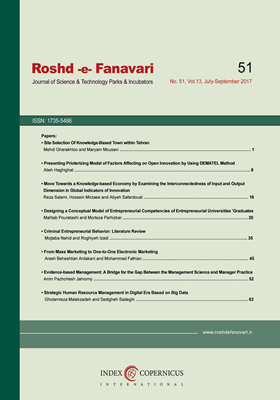از بازاریابی انبوه تا بازاریابی الکترونیکی یکبهیک
الموضوعات : Technology Managementآرش بهشتیان اردکانی 1 , محمد فتحيان 2
1 - دانشگاه علم و صنعت ایران
2 - دانشگاه علم و صنعت ایران
الکلمات المفتاحية: بازاریابی انبوه بازاریابی الکترونیکی بازاریابی یکبهیک مدل سازی پاسخ فناوری اطلاعات,
ملخص المقالة :
روشهای سنتی بازاریابی، تمرکز بر پوشش عده زیادی از مشتریان در مقیاس وسیع و با تبلیغات یکسان دارند و نظرات مشتریان مختلف را در نظر نمیگیرند. این تبلیغات با وجود هزینه زیاد، تعداد اندکی از مشتریان هدف را جذب مینمایند. این بدان معنا است که قسمت اعظمی از بودجه بازاریابی اتلاف میشود. با پیشرفت فناوری اطلاعات، اینترنت، تجارت الکترونیکی، کسبوکارهای الکترونیکی و توسعهی انواع مدلهای بازاریابی الکترونیکی، شرکتها موفق به دریافت اطلاعات کاربران بهصورت بلادرنگ و با هزینه کمتر شدند. رشد روزافزون دادههای مشتریان، افزایش فضای رقابت و قابلیتهای جدید فناوری اطلاعات، شرکتها را به سمت بهبود استراتژیهای بازاریابی با در نظر گرفتن ارتباط مستقیم با مشتریان و اجرای بازاریابی یکبهیک سوق داده است. همچنین برای افزایش موفقیت بازاریابی یکبهیک و شناسایی مشتریانی که با احتمال بیشتری به فعالیتهای بازاریابی پاسخ مثبت میدهند، میتوان از مدلسازی پاسخ استفاده کرد. در این مقاله، ابتدا مشکلات ناشی از بازاریابی انبوه و لزوم حرکت به سمت روشهای نوین بازاریابی مطرح شده است. سپس سیر تحول استراتژیهای بازاریابی، از بازاریابی انبوه و سنتی تا بازاریابی الکترونیکی یکبهیک با استفاده مؤثر از فناوری اطلاعات، مورد بررسی قرار گرفتهشدهاند. در ادامه آن نیز به تشریح اجزای اصلی بازاریابی الکترونیکی یک به یک پرداخته شده است. شرکتها با شناسایی و اعمال مراحل اصلی بازاریابی یکبهیک الکترونیکی، که در این مقاله ارائه شدهاند، میتوانند در راستای جذب مشتریان جدید، ترغیب مشتریان فعلی به خرید و حفظ مشتریان وفادار و درنتیجه افزایش سودآوری خود گام بردارند.


